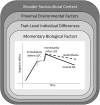Affect Dysregulation in Context: Implications and Future Directions of Experience Sampling Research on Affect Regulation Models of Loss of Control Eating
- PMID: 34646178
- PMCID: PMC8502879
- DOI: 10.3389/fpsyt.2021.747854
Affect Dysregulation in Context: Implications and Future Directions of Experience Sampling Research on Affect Regulation Models of Loss of Control Eating
Abstract
Loss of control eating is a core, transdiagnostic eating disorder symptom associated with psychological distress, functional impairment, and reduced quality of life. However, the factors that contribute to persistent loss of control eating despite negative consequences are not fully understood. Understanding the mechanisms that maintain loss of control eating is crucial to advance treatments that interrupt these processes. Affect regulation models of loss of control eating hypothesize that negative emotions trigger loss of control eating, and that loss of control eating is negatively reinforced because it temporarily decreases negative affect. Several variations on this basic affect regulation model have been proposed, including theories suggesting that negative affect decreases during loss of control eating rather than afterwards (escape theory), and that loss of control eating replaces one negative emotion with another that is less aversive (trade-off theory). Experience sampling designs that measure negative affect and eating behavior multiple times per day are optimally suited to examining the nuanced predictions of these affect regulation models in people's everyday lives. This paper critically reviews experience sampling studies examining associations between negative affect and loss of control eating, and discusses the implications for different affect regulation models of loss of control eating. The review concludes by proposing an expanded affect-focused model of loss of control eating that incorporates trait-level individual differences and momentary biological and environmental variables to guide future research. Clinical implications and recommendations are discussed.
Keywords: binge eating; ecological momentary assessment; emotion regulation; experience sampling; loss of control eating; negative affect.
Copyright © 2021 Mikhail.
Conflict of interest statement
The author declares that the research was conducted in the absence of any commercial or financial relationships that could be construed as a potential conflict of interest.
Figures


Similar articles
-
Examining intra-individual variability in food-related inhibitory control and negative affect as predictors of binge eating using ecological momentary assessment.J Psychiatr Res. 2020 Jan;120:137-143. doi: 10.1016/j.jpsychires.2019.10.017. Epub 2019 Oct 26. J Psychiatr Res. 2020. PMID: 31677551 Free PMC article.
-
Fluctuations in negative emotions predict binge eating both in women and men: An experience sampling study.Eat Disord. 2017 Jan-Feb;25(1):65-79. doi: 10.1080/10640266.2016.1241058. Epub 2016 Oct 24. Eat Disord. 2017. PMID: 27775488
-
Negative affect, interpersonal perception, and binge eating behavior: An experience sampling study.Int J Eat Disord. 2015 Sep;48(6):715-26. doi: 10.1002/eat.22410. Epub 2015 May 6. Int J Eat Disord. 2015. PMID: 25946681 Review.
-
Longitudinal associations between emotion regulation skills, negative affect, and eating disorder symptoms in a clinical sample of individuals with binge eating.Eat Behav. 2019 Jan;32:69-73. doi: 10.1016/j.eatbeh.2018.12.005. Epub 2018 Dec 28. Eat Behav. 2019. PMID: 30654193 Free PMC article.
-
Emotion Regulation in Binge Eating Disorder: A Review.Nutrients. 2017 Nov 22;9(11):1274. doi: 10.3390/nu9111274. Nutrients. 2017. PMID: 29165348 Free PMC article. Review.
Cited by
-
A daily diary study of emotion regulation as a moderator of negative affect-binge eating associations.Int J Eat Disord. 2022 Oct;55(10):1305-1315. doi: 10.1002/eat.23768. Epub 2022 Jul 2. Int J Eat Disord. 2022. PMID: 35779074 Free PMC article.
-
State negative affect in relation to loss-of-control eating among children and adolescents in the natural environment.Appetite. 2022 Nov 1;178:106166. doi: 10.1016/j.appet.2022.106166. Epub 2022 Jul 15. Appetite. 2022. PMID: 35850381 Free PMC article.
-
Heart Rate Variability and Laboratory-Based Loss-of-Control Eating in Children and Adolescents.Nutrients. 2022 Sep 28;14(19):4027. doi: 10.3390/nu14194027. Nutrients. 2022. PMID: 36235684 Free PMC article.
-
The association between mental health and Bulimia Nervosa among a sample of Lebanese young adults: the indirect effect of difficulties in emotion regulation.BMC Psychiatry. 2023 May 12;23(1):335. doi: 10.1186/s12888-023-04847-0. BMC Psychiatry. 2023. PMID: 37173734 Free PMC article.
-
Lifetime stressor exposure, eating expectancy, and acute social stress-related eating behavior: A pre-registered study of the emotional eating cycle.Appetite. 2023 Jun 1;185:106494. doi: 10.1016/j.appet.2023.106494. Epub 2023 Feb 17. Appetite. 2023. PMID: 36805424 Free PMC article.
References
Publication types
LinkOut - more resources
Full Text Sources

